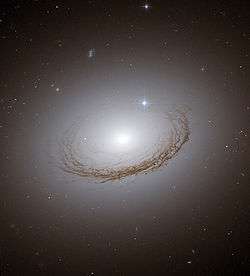NGC 7049
| NGC 7049 | |
|---|---|
|
NGC 7049 - image from the Hubble Space Telescope's Advanced Camera for Surveys | |
| Observation data (J2000 epoch) | |
| Constellation | Indus |
| Right ascension | 21h 19m 00.25s[1] |
| Declination | −48° 33′ 43.24″[1] |
| Redshift | 2285 km/s[1] |
| Distance | 100 Mly[2] |
| Apparent magnitude (V) | 10.7[1] |
| Characteristics | |
| Type | S0 |
| Size | ~150,000 ly[2] |
| Other designations | |
| ESO 236-1,[3] PGC 66549[1] | |
NGC 7049 is a lenticular galaxy that spans about 150 000 light-years and lies about 100 million light-years away from Earth[2] in the inconspicuous southern constellation of Indus.
NGC 7049's unusual appearance is largely due to a prominent rope-like dust ring which stands out against the starlight behind it. These dust lanes are usually seen in young galaxies with active star-forming regions. NGC 7049 shows the features of both an elliptical galaxy and a spiral galaxy, and has relatively few globular clusters, indicative of its status as a lenticular type.[4]near the galaxy's center. NGC 7049 is the brightest (BCG) of the Indus triplet of galaxies (NGC 7029, NGC 7041, NGC 7049), and its structure might have arisen from several recent galaxy collisions. Typical BCGs are some of the oldest and most massive galaxies.[5]
References
- 1 2 3 4 5 "NASA/IPAC Extragalactic Database". Results for NGC 7049. Retrieved 2016-11-18.
- 1 2 3 "Unusual Dusty Galaxy NGC 7049". Retrieved 18 November 2016.
- ↑ "SIMBAD Astronomical Database". Results for NGC 7049. Retrieved 2016-11-16.
- ↑ The Astronomical League
- ↑ Nemiroff, R.; Bonnell, J., eds. (8 April 2009). "Unusual Dusty Galaxy NGC 7049". Astronomy Picture of the Day. NASA.
External links
![]() Media related to NGC 7049 at Wikimedia Commons
Media related to NGC 7049 at Wikimedia Commons
